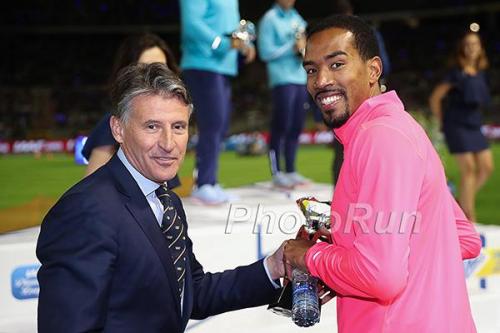We are in a time of much change in our sport. The IAAF and Diamond League are looking at how to change the major meeting group in the sport. Lots of questions here. The release gives an early indication of how seriously the IAAF is taking the change in our sport.
But, the question is, what to change and what to keep?
RelatedPosts
More on that later.
 Seb Coe and Christian Taylor, photo by PhotoRun.net
Seb Coe and Christian Taylor, photo by PhotoRun.net
The General Assembly of the IAAF Diamond League met today in London’s Olympic stadium to review the 2017 season and the structure of the sport’s top tier one-day meeting circuit from 2020 and beyond.
The 2017 season marked the first stage of a fundamental restructuring of the IAAF Diamond League which adopted a championship-style model with the finalists competing for a prize pool of $3.2 million.
282 million viewers from across 161 countries worldwide switched on during the season to watch the world’s top athletes earn points in the first 12 IAAF Diamond League meetings to qualify for two final meetings, where $100,000 was at stake in each of the 32 Diamond disciplines, including $50,000 for each winner.
Emphasising the Diamond League’s global credentials, 805 athletes from 86 countries took part in the 2017 season, with 39 countries producing winners across the 14-meeting series.
When the changes were announced in December 2016, IAAF President Sebastian Coe confirmed that “it is important to assess the Diamond League’s impact and build for the future. These decisions are the first step to growing the attractiveness of the series.”
Today Coe reconfirmed the IAAF’s commitment to the series, a future based upon a programme of radical change aligned to wider reform across the IAAF’s Competition programme. “Right across the sport there is a commitment to change. We need to give our athletes a compelling reason to compete and our fans a compelling reason to come back to our sport week in and week out. This is a revolution for us and it means facing up to the reality of how people – not just young people – are and want to consume our sport.”
This is a consultative process and currently there are four important pillars of work underway. The first is the general overhaul of the global calendar; second is the introduction of an IAAF World Rankings system; third is a comprehensive review of the entire Diamond League structure; and fourth, going to market for a new title sponsor.
The goal is to create a future IAAF Diamond League which grows the fan base, fits into a comprehensive annual calendar, supports all meetings, and delivers a prosperous circuit, challenging the status quo of a one-day meeting format which has broadly remained unchanged since the early 1960s.
“Across all four, nothing is off the table,” confirmed Coe. “I have asked our teams to be open, creative and brave. We are in the entertainment business and we have to look at it in that way. Our sport is strong and we have had a phenomenal year of great performances and exceptional audiences in Uganda, The Bahamas, Kenya and across the Diamond League series, culminating in the amazing World Championships in London in August. But all sports are fighting for fans and thinking of new and different ways to present their sport or alter their core concepts and formats. We need to do the same.”
The timeline is to deliver a new structure – which would be implemented in 2020 – in the first quarter of 2018.





















